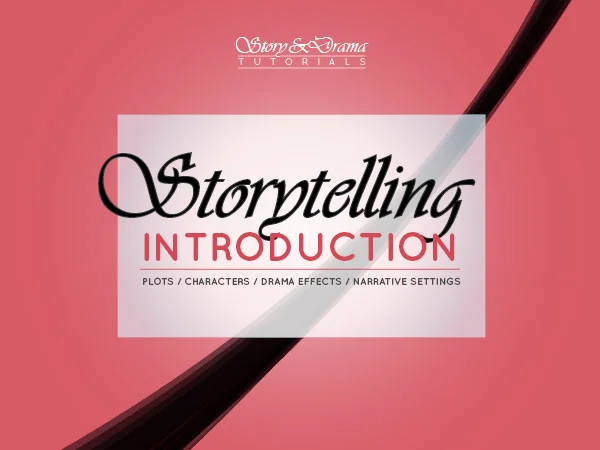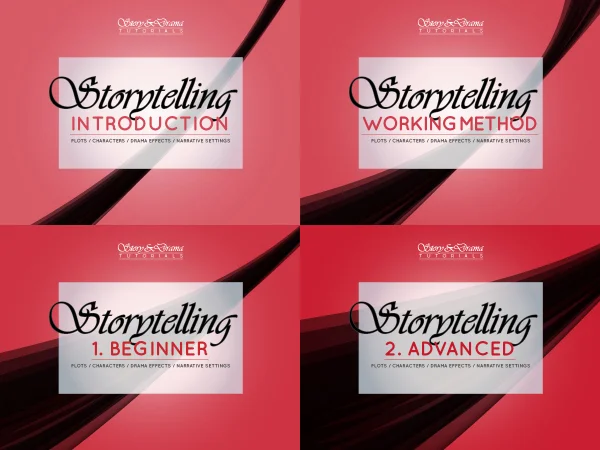 |
|
|
PDF, 20 pages
|
Free!
|
| Read the Free storytelling tutorial in PDF | |
This page is an abstract from our free storytelling tutorial in PDF.
Table of contents
- 1. What is storytelling?
- 2. Plots
- 3. Characters
- 4. Mixing plots
- 5. Drama effects
A plot tells what happens to a Hero
There is (nearly) always at least one character that we follow all along the plot. This is the main character. He, she, or it is very important.
Whereas it is just words or pictures or whatever else, some great works make us feel like characters are real and even “more than real”. How to do that? Some character’s power is so strong, that some people in the audience will get very attached to them, praise them like idols, copy their lifestyle, repeat their famous lines, fall in love with them…
Dramatic and non-dramatic characters
Some characters are central, needed, dramatic (like a lover discussing in a cafe with his girlfriend) and thus have dramatic properties:
- Goal (and sub-goals)
- Motivations
- Strengths and weaknesses
- Theme properties (=flesh)
Some other characters are not dramatic, not necessary, they could be removed (like the neutral customers in the cafe in the previous situation). They do not need dramatic properties.
Here is an example of dramatic properties:
| Radiohead’s music video “RABBIT IN YOUR HEADLIGHTS” | |||
| LONELY WALKER vs. CARS | |||
| LONELY WALKER | CARS | ||
| Goal | Walk? Get out of the tunnel? | Goal | Pass by, across the tunnel |
| Motivation | (Untold) | Motivation | (Untold) |
| + | – | + | – |
| Resistant Determined |
Alone Vulnerable Crazy |
Many Strong, solid |
Weaker than flesh in the end!! |
A plot tells the conflict between a MAIN CHARACTER and his/her ANTAGONIST
This conflict is fundamental and necessary: if there’s no opposition, there’s no drama and no dramatic energy to play on!
The other characters are there to get involved in the main conflict, add their forces, play a role.
- HERO VS ENEMY
- Columbo VS Criminal
- Rocky VS Champion
- Rambo VS Small town
- Spaceship team VS Alien
Hero and Antagonist have Helpers, Mentors and Skeptics
Our main characters have other dramatic characters to help, support or contradict them. We call them all “actantial roles“: characters taking roles in the action.
We make the difference between actantial roles and thematic roles that carry the identity of the characters. The tutorial Storytelling 2. Advanced studies actantial and thematic roles in Pulp Fiction and in Nip/Tuck.
- Helpers are characters who perform actions in favor of their leader, either the Hero or the Antagonist.
- Mentors are characters who provide information and motivation to the Hero or Antagonist.
- Skeptics have the contrary role: to discourage, to contradict the motivations and goals of a Hero or an Antagonist.
Here is the typical set of characters as actantial roles:
| Mentor | Skeptic | Mentor | Skeptic |
| Hero | Enemy | ||
| Helper | Helper | Helper | Helper |
| Helper | Helper | Helper | Helper |
And here is one example from The Godfather:
| The Godfather, main plot | |||
| Barzini | |||
| Vito Corleone | Tattaglia | ||
| Sonny | Michael | Sollozzo | Bruno Tattaglia |
| Tessio | Tom Hagen | Capitaine McCluskey | Tessio |
| Fredo/Carlo | Various killers | Fredo/Carlo (as traitors) | Various killers |
Storytelling 4-tutorials Pack
Story&Drama offers you 4 scenario tutorials for $30
Get them all at once and download them immediately.
 |
|
4 PDF
|